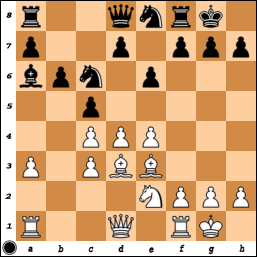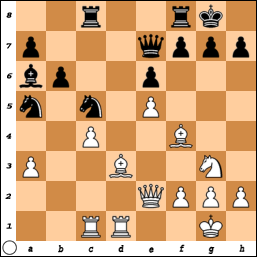With regard to the Bad Harzburg open, I will try to post updates, but noone knows whether this will work out, given that two games are to be played on most days and I'll also have some teaching duties there.
Oliver Uwira (2251) - Jean-Michel Kempenich (2089)
Saverne - Sarreguemines (Nationale III)
1. d4 Nf6 2. c4 e6 3. Nc3 Bb4 4. a3 Bxc3+ 5. bxc3 c5 6. e3 O-O
More precise is 6... b6! 7. Bd3 Bb7 8. f3 because with the pawn at f3 it is more difficult to bring the queen to the kingside, unless White commits to playing f3-f4. The resulting loss of tempo Bc8-b7-a6 is made up by White having to play f2-f3-f4. White cannot try to take advantage of the black moveorder by means of 8. Ne2?. This is an unsound pawn sacrifice, which is refuted by 8...Bxg2 9. Rg1 Be4! 10. Bxe4 (not 10. Rxg7? Bg6 and Black wins) 10...Nxe4 and Black is clearly better, as 11. Rxg7?! is followed by 11...Qf6 12. Rg2 Nc6 and White is in deep trouble.
7. Bd3 Nc6 8. Ne2 b6 9. e4 Ne8 10. O-O Ba6 11. Be3!?

This is a rarely played attempt to exploit the fact that Black has not forced the white f-pawn to advance yet. If Black plays 11...d6, White can prevent the blockade f7-f5 by means of 12. Ng3, which will give a subsequent advance f2-f4 a lot more punch than usual.
11...d6?!
Much better is 11... Nd6! when after 12. dxc5 Nxc4 13. Bxc4 Bxc4 14. Re1 Black has good play on the light squares.
12. Ng3 cxd4 13. cxd4 Na5 14. Qe2 Rc8 15. Rac1
Now White is ready for the push f2-f4-f5 which would yield a strong kingside attack.
15...Nf6
Black tries to improve the position of his knight, but by doing so he allows White to open the flood gates on the kingside. Nevertheless, this seems to be the best move for Black.
16. e5! dxe5 17. dxe5 Nd7 18. Rfd1 Qe7
Now White's queenside lies in ruins. Therefore, his success hinges on an exact conduct of his kingside attack.
19. Bf4!
Moves like f2-f4 are completely unacceptable. The dark-squared bishop would be dearly missed on the kingside.
19...Nc5?
Natural but disastrous. Black believes that he is winning a tempo, because the white bishop is seemingly too precious to give it up. This is not the case but White succumbs to the same illusion.

20. Bb1?
After 20. Nh5!! Black is stone dead, e.g. 20...Nxd3 21. Qg4 f6 22. exf6 Qf7 23. Rxd3 and Black's kingside will collapse.
20... Rfd8?
Black is not sensing the danger, as his previous move has already shown. Now the white attack gets going again - and this time Black will not be let off the hook again.
Houdini 1.5 likes 20... Qh4! - this move was also suggested by my opponent during the post-mortem. We then analysed 21. Nh5 for at least 30 minutes without finding salvation for Black. Houdini's suggestion is the apparently ridiculous 21...f5! with the surprising point that after 22. exf6 g6 the white knight does not have access to f6, turning the tables against White.
21. Qg4! Rxd1+ 22. Rxd1 Rd8 23. Re1

23...Rd4
This accelerates Black's demise, but there was no rescue in sight in any case. Black has parked the bus on the queenside, leaving his king outgunned by five white attackers.
24. Nh5!
Either Black will be mated or he will lose heaps of material.
24...Kf8 25. Qxg7+ Ke8 26. Bg5 Qb7 27. Nf6+ Kd8 28. Nd5+ Kd7 29. Qxf7+ Kc6 30. Nb4# 1-0


No comments:
Post a Comment